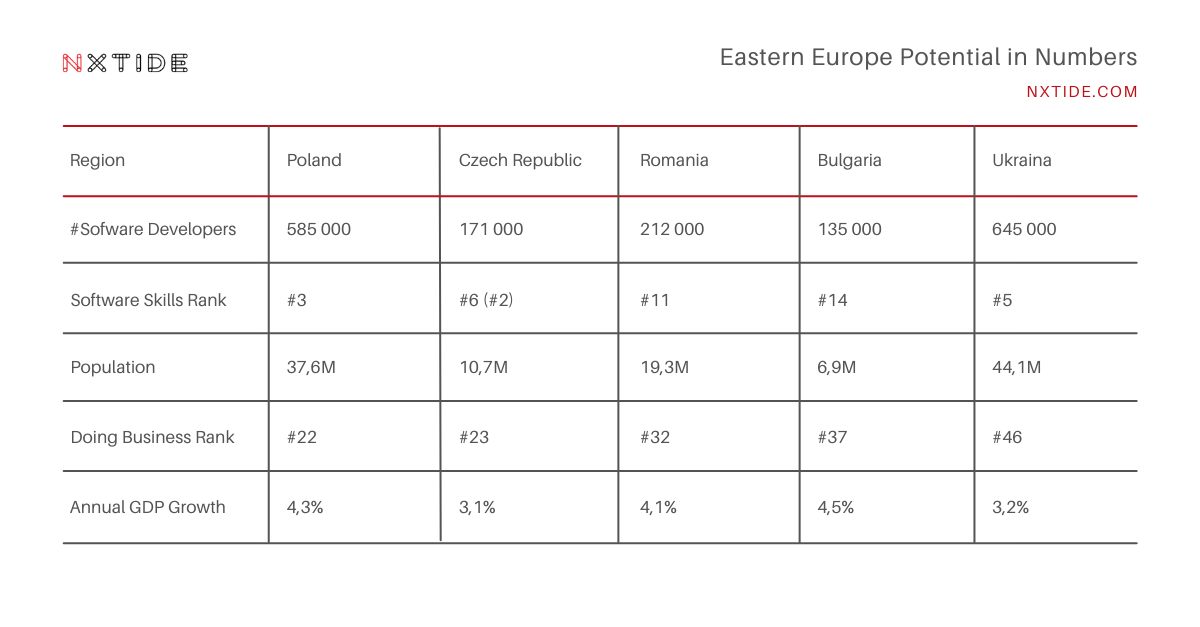How to Tackle a Shortage of Software Developers in 2022 and Beyond?

How to Tackle a Shortage of Software Developers in 2022 and Beyond?
The global talent shortage of software developers is a pressing concern for businesses and organizations across the world. In order to stay ahead of the curve, it’s important to understand the root causes of this shortage and how to mitigate them.
In this article, we will try to explain the significance of this problem and find some solutions to help businesses tackle it. Read on!
The current status and forecasts of global shortage of software engineers.
Job vacancies and skills gaps are increasing at an accelerated rate in a number of sectors. Finding the appropriate talent has become increasingly difficult, regardless of your area. According to a study by McKinsey & Company, 44 percent of large businesses expect skill shortages in the next five years. 87 percent believe that the impact is already being felt, with many concerned it
The skills shortage gap is also being exacerbated by emerging technologies and trends. McKinsey’s study shows that three out of ten managers expect technological changes to disrupt at least three-quarters of their company’s job positions over the next half decade. Financial technology, software development, and telecom are among the industries that will be affected.
In a separate research, 69 percent of worldwide employers struggle to connect open positions with the appropriate talents that have trustworthy skill sets. This covers strictness, responsibility, resilience, and stress tolerance. Remember that stressed employees might lose up to 5 hours of productivity each week. As a result, around one-third of businesses use technology and automated systems to get around this skills gap.
The demand for software developers is increasing at an alarming rate.
But what’s the future outlook of software talent developer shortage in numbers? Will the demand for quality software developers continue to proliferate? First, the number of job vacancies in software projects will rise by 22% by the time we clock 2030. Remember, the national average growth rate in the US is 8%, meaning we are already looking at an overwhelmed industry with a severe shortage. Moreover, Gartner forecasts a $3.9 trillion sector of AI-powered businesses by the end of 2022. In other words, the number of potential employers is also increasing at an alarming rate.
Today, the question isn’t whether there are enough software developers in the world; it’s how to deal with the shortage. The worldwide dearth of software developers will reach an all-time high of 40 million people in December 2020, according to experts, and grow to 85.2 million by 2030.
Furthermore, because the global software developer shortage crisis is getting worse, international businesses could lose up to $8.4 trillion in revenue in the next decade.
It’s also worth noting the rising of blockchain technology disruption in many industries. The talent gap in crypto is even worse since the industry is still navigating its nascent stage. A recent Xpheno report shows that active blockchain job openings in India and the larger Asian region have grown by 50% since 2020. Currently, we have more than 12,000 unfilled job openings, and the numbers could go higher as many tech firms expand their operations to the region.
These are not uplifting data for companies already having trouble finding personnel. However, employing software developers in nearshore or offshore locations like Asia, Eastern Europe, south America where there is “some surplus” may mitigate the risks.

How does the global software engineers shortage impact companies?
The scale of shortage of software engineers and tech talent, for instance, in the US is very alarming. CNBC news notes the rate can be up to 918,000 unfilled IT job vacancies every three months. In 2019, job postings around the tech industry increased by 32%. Still, 60,300 IT professionals graduating with a degree in computer science are not enough to meet this demand.
What does this shortage mean for a typical company? Remember, in 2021 and beyond, every business is a tech firm. Whether you’re automating sales or customer support, you’ll need to hire a technical employee at some point. As a result, it’s critical to understand how this significant talent deficit affects you.
1) The operational consequences of a software developer shortage and tech talent gap.
Businesses are forced to spend more on salaries and incentives in order to attract or keep the few skilled individuals available. As a result, small firms can’t compete effectively with big businesses. According to Evans Data Corporation, the number of full-time software developers in the United States is expected to be 4.3 million by 2021. All of these workers make an average wage of around $107,510. This expenditure is prohibitively expensive for a typical small business. Furthermore, there is strong demand for highly qualified IT professionals.
2) Declining or stagnant innovation rate across the board
A deficit of software developers has a detrimental effect on product performance and innovation. For example, if a company can’t hire specialists to fill difficult-to-fill vacancies, it will suffer from decreased performance. Positions that need some amount of expertise, such as two years of experience, are examples of hard-to-fill job openings. According to Bennet and McGuiness, removing hard-to-fill job positions may result in a 65% decrease in productivity. Job openings at the beginner level have the potential to reduce output and innovation by up to 75%.
According to the latest reports, a declining number of innovation projects being launched in Germany is directly corelated with the growing number of unfilled IT employment openings. To put it another way, owing to a shortage of skilled staff, businesses are unable to fill open positions and drive innovations.
3) Limited business growth

IT expenditure is frequently a cost for many organizations. On the other hand, like any other department in the company that influences overall success, the IT department has its own goals and objectives. Software engineer scarcity can stifle business development. More enterprises are moving to cloud-based operations these days. When an industry deficiency exists, businesses struggle to achieve beyond the survival stage of adopting technological trends.
Software developer shortage is a warning sign that has immediate consequences for overall operational performance. Overworked employees experience burnout and morale issues. It will just be a matter of time until some people stop coming to work. In the long run, the business fails to meet its goals and client demands. This might encourage loyal customers to explore alternatives to fulfill their needs.
HR challenges employers face due to a shortage of software developers.
The West Monroe recently interviewed executives in the United States, and 77 percent of them cited a variety of problems they encounter when recruiting due to a scarcity of coders. These difficulties are not limited to just one sector – it actually affects all industries.
Let’s look at five challenges that business leaders face in hiring a team or individual software developers to lead their innovation projects.
1) Rising costs of recruitment
Many business owners spend up to 40% of their time on tasks that don’t add high value to their organization, including recruitment. In addition to this, it can cost a business up to $4,129 to fill a job vacancy within 42 days. This time frame is not even enough if you’re dealing with seasonal demand. In other words, the kind of investment employers make amidst the ongoing software developer talent shortage can be pretty overwhelming, especially if the ROI is not impressive, even after onboarding a candidate.
2) Depleted talent pools

The number of software development jobs are rising at a unprecedented pace. By now, every IT-based business knows that it’s difficult to fill vacancies due to a limited pool of talents across the industry. Even if you find a potential candidate, they may not possess the necessary skill set that matches your business’s needs, goals, and vision. Remember, the increasing number of graduates in the industry still doesn’t solve the skills set challenge.
3) Rising salary demands
According to the US Bureau of Labor Statistics, there will be nearly 1.4 million additional software development positions in 2020. However, we only had 400,000 new IT graduates that year who could fill the openings. This significant gap explains why existing software developers and engineers will continue to demand larger salaries.
However, the amount of salary that a business can offer on a software development job depends on the talent’s level of expertise, location, and tech stack. Nevertheless, keep in mind that retaining a full-time developer will cost you more than a remote specialist.
4) Enourmous tech talent competition among employers on the job market
HR managers confirm that about 75% of potential software engineers are not actively looking for a new job offer and they don’t show enough effort in the recruitment process.? 53% of these candidates have multiple job offers, others offer better salaries, working environment, and general compensation schedules.
And this is getting worse every year. Every business outside there, whether big or small, is hunting for the right software developer. Hiring developers mean that you have to offer better perks if you’re going to attract the right talents to your job board and possibly retain them after onboarding.
5) The shift towards IT and computer science graduates
In the IT industry, hiring difficulties don’t end at simply higher recruitment costs or a restricted pool of talents. When it comes to recruiting, 39% of recruiters cite insufficient software development education as being a bigger problem. As a result, boot camp graduates are becoming increasingly popular among hiring managers (23 percent) in place of university grads (39 percent).
Boot camps also have a higher rate of applications than university graduates. Although they can assist the sector close the gap, most businesses don’t want them. Hiring a boot camp graduate entails investing more in training and onboarding. They also can’t take on difficult-to-fill openings since the vast majority of them have little to no industry expertise.
The solutions to tackle software engineers shortage
Solving the talent shortage in the industry takes two to tango. Ideally, both IT companies and businesses should work in tandem to put this crisis to an end, or at least mitigate it to minimize disruptions. You don’t have to wait until a job position becomes difficult to fill as a business owner. Instead, try to tackle the problem right away with the following solutions:
1) Invest in training and specialized skills development
The best way to solve a skills shortage is by training and upskilling your workforce, including those who are not in the IT field. For businesses, this will entail investing in specialized programs that target employees from other departments who want to transition into software development. The good news is that you can get government funding for such initiatives.
2) Offer better perks and remunerations
Sometimes, addressing the software developer gap starts with keeping the team you already have. When looking for new talent that matches their technical abilities and expertise, it’s not practical to lose workers. It’s easier to keep existing employees committed by increasing benefits and pay. This will encourage your staff to stay put even after they receive attractive job prospects from other industry participants
When your company reaches its maximum potential with rising demand, raising salaries and compensation packages is a good plan. You don’t want to experience any shortages that would disrupt service delivery in that case. This remedy does not apply to small businesses just getting started, though.
3) Hire additional freelancers
Freelancers can help the industry solve this software developer shortage temporarily. Usually they can be found through advertisements on websites where they display services, availability, and rate cards. Even better, you can opt for freelancing sites that usually feature multiple talents for your perusal. Freelancers are a go-to option if you want to meet seasonal demands.

Working with freelance software engineers, on the other hand, has its challenges. Be cautious when outsourcing core responsabilities to people you don’t know. The huge part of of them might not have the abilities they claim in their resumes. You’ll also have to deal with time zone issues and language difficulties.
4) Hire software development teams
Outsourcing software development teams is another solution to the talent crisis. It’s perfect for businesses that want to focus on their core operations and outsource specific functions, like software development, to a specialized team. By doing this, you can mitigate the risk of a talent shortage in the future.
The best thing about outsourcing is that you get a team with the right skillset who are up for the job. They also come with the right cultural fit, which is essential for seamless communication and collaboration. However, it can be expensive, and working with an offshore team requires additional management time from your end.
5) Open your own nearshore development office or offshore development center
You can have all the resources to pay better in terms of salary and compensation packages. However, that may still not be enough to counter the software developer talent shortage in the industry. In that case, it will help if you revisit your hiring strategies and extend your hunting to countries without a shortage of software engineers, such as Poland, Romania, Ukraine.
Software development firms in the CEE region employ over 1 210,000 specialists ready to meet your growing demand. Moreover, outsourcing IT to those countries is relatively affordable as opposed to other countries, thanks to the bigger talent pool.
If you want to fill orders, expanding your talent acquisition approach by utilizing remote software engineering teams in other areas is a good idea. It’s also a popular choice if you can’t hire the appropriate experts from inside your country.
An offshore development center (ODC) is an entity that’s a part of your company but exists in another country. The main purpose of establishing an ODC is to utilize the talents in that area without incurring high talent acquisition and operation costs.
A nearshore development office is located in the same continent and is an excellent solution for companies that want to have more control over the software development process. By being closer to the action, you can manage projects more efficiently and avoid unfortunate surprises.
All two solutions can work under “Build Operate Transfer” (BOT) contract type. It would give you an ability to get full transparency, control and knowledge about how the product is being built.
BOT contract type is perfect for companies that:
– want their own dedicated team but are not ready to organize an in-house department from scratch;
– want to avoid management risks and unexpected costs associated with building their own development office;
– are not sure whether they need an in-house team or not, and want to try working with a dedicated team first.

Create a Nearshore Software Development Office with NxTide
Over our 7-year company activity we have helped many US and EU companies to successfully build Software Development Teams and Software Development Centers in a variety of locations in Poland.
Interested? – Let’s discuss your case on a call.
Marcin Dziedzic, CEO of Pragmatic Coders and NxTide.
Finding the right nershore/offshore development partner.
Utilizing all the options we’ve mentioned will require some time and effort to be put into research. The best way to find a good partner is by looking for companies with a strong reputation, years of experience, and a team of skilled engineers.
Make sure to vet any potential partner carefully before signing any agreements. Check out their portfolio, read reviews, and get in touch with their past clients to get a better idea of what working with them would be like.
NxTide helps to overcome the software developer talent shortage.
NxTide is a software development company that specializes in helping businesses overcome the talent crisis. We have a team of skilled engineers who are up for the job, no matter how challenging it may be. What’s more, our team comes with the right cultural fit, which is essential for seamless communication and collaboration. If you want to fill orders and expand your talent acquisition approach by utilizing remote software engineering teams, we can help.
Please take a closer look at a dedicated and flexible offer we have prepared based on market needs:
1) Software Development Teams: dedicated to clients looking to expand their software development teams or create small remote teams from scratch.
2) Offshore Development Center: dedicated to larger and permanent projects. We’ve implemented the innovative Build Operate Transfer model to make the whole process faster, more efficient, and transparent.
3) Nearshore Software Development Office: dedicated to larger and permanent projects within the same region, continent.

Kraków
Over 0,8M population, 13% of total IT Engineers supply

Warsaw
Over 1,8M population, 24% of total IT Engineers supply

Wrocław
Over 0,7M population, 12% of total IT Engineers supply

Katowice
Over 1,8M population, 9% of total IT Engineers supply

Poznań
Over 0,7M population, 8% of total IT Engineers supply

Łódź
Over 0,7M population, 7% of total IT Engineers supply

Gdańsk
Over 0,6M population, 6% of total IT Engineers supply

Bydgoszcz
Over 0,5M population, 4% of total IT Engineers supply
Other related articles that might interests you:

Global Offshore Software Development Rates Comparison by Country
Home Global Offshore Software Development Rates Comparison. The global software developers workforce market overview.The worldwide business software and services market…

10 Reasons Why IT Outsourcing in Poland is Growing Rapidly
Home 10 Reasons Why IT Outsourcing in Poland is Growing Rapidly In recent years Poland as long as the whole…

Scaling Software Development Teams with Nearshore Developers.
Home Scaling Software Development Teams with Nearshore Developers. When a software team reaches a certain point in its development process,…
